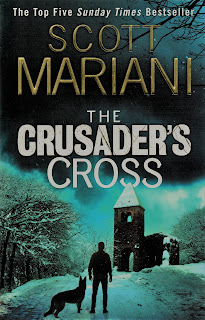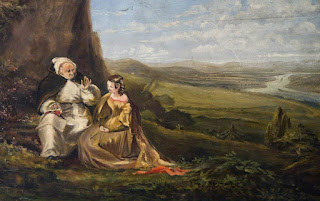The first series of
The Chronicles of the Canongate is a collection of three short (of uneven length) stories, which are linked together by a common narrator,
Chrystal Croftangry. At least as interesting as the narrator's own story and his Tales is
Scott's Introduction, where he not only (finally) confesses his authorship but he explains how his
learned and respected friend,
Lord Meadowbank, 'unfrocked' him publicly at a public meeting, called on 23rd February 1827 to establish a professional Theatrical Fund in Edinburgh. Scott acknowledged himself to be
the sole and unaided author of those Novels of Waverley. The author then went on to thank those who had given him ideas for his novels (Mr Joseph Train for
Old Mortality's history; an unknown lady correspondent for the story of
'Jennie Deans'; and a family member for the gist of the
Bride of Lammermoor), arguing that he had
always studied to generalise the portraits, so that they should still seem, on the whole, the productions of fancy, though possessing some resemblance to real individuals. He also drew attention to the originals of such castles as Wolfs-Hope and Tillietudlem. The scraps of poetry (which I rarely read!) are mainly pure invention.
As for Chrystal Croftangry - it is soon clear that much of his character is partly based on Scott himself. Chrystal's return to his family home, now turned into Castle-Treddles is poignantly done and the portrait of old Christie Steele, Chrystal's mother's body servant, now in charge of a dilapidated inn, includes some splendid dialogue. Chrystal soon retreats to Auld Reekie and decides to live there, but not in St George's Square - nor to Charlotte Square - nor to the old New Town - nor to the new New Town - nor to the Carlton Hill, but to the Canongate, scene of earlier misfortunes. Here the 60 year-old takes on as housekeeper another of Scott's indubitable characters, the forthright Mrs Janet MacEvoy, who owed nobody a bodle.
We thus approach the first Tale, which has a narrator once removed - Mrs Martha Bethune Baliol, a person of quality and fortune. Living in some old-fashioned style in the Canongate (Baliol's Lodging), she befriends Chrystal and, on her demise leave a promised Memorandum to the latter - hence The Highland Widow. Nearly 40 years earlier, Mrs Baliol had met Elspat Mactavish, the widow of MacTavish Mhor, (largely modelled on Rob Roy) one of the last of the Highland marauders, shot as a Jacobite after Culloden. Elspat had lived alone with her son, Hamish Bean Mactavish. His mother wants her son to mirror his father's way of life; he demurs, sensibly choosing to join a Government regiment destined for America. Thus he can replicate his father's courage in honour and safety. Visiting his mother on furlough, she drugs him and he sleeps beyond his leave; which means he appears to have absconded. He is then goaded by his mother into shooting the officer (and friend) sent to arrest him. Hamish is tried and executed. His mother spends the rest of her life in solitary mourning. John Buchan remarks, Elspat MacTavish is perhaps too reminiscent of Helen MacGregor, [but] there is tragedy in her stubborn savagery and the son Hamish is drawn with sober faithfulness.
The second Tale, The Two Drovers, is much shorter (64 compared to 147 pages). It is based on an account Scott had heard of the trial and execution in Carlisle of a Highland cattle drover accused of the murder of an English counterpart. Set in the late 18th century, it is an illustration of the Highland concept of honour. Robin Oig M'Combich - small of stature with an elasticity of step - travels south with his friend of some three years, Harry Wakefield, a Yorkshireman. A conflict arises over temporary pasturage, which both thought they had been given; Harry fist-fights Robin to the floor of the Inn they are drinking at. Robin retraces his steps to retrieve a dirk, returns to the inn, and kills Harry. He gives himself up for the inevitable execution, happy to forfeit his life for the life he took. Alongside this tragedy, the author gives a compelling picture of life on the old drove-roads. Of course, there has to be a spaewife/auld Highland witch (Janet of Tomahourich, Robin's aunt) tacked on to the story, with her second-sight (Taishataragh) about Robin's dirk having English blood on it. Too true, as it turns out!
Addendum: I have just read an essay by J. T. Christie on the Chronicles of the Canongate, which includes this perceptive piece on The Two Drovers: The contrast between the wild Highland heart and the genial short-lived pugnacity of the Southerner is a common theme in Scott: reason versus romanticism, the Hanoverian against the Highlander. He could do justice to both sides, and in his own heart they were never fully reconciled. Hence much of his grandness as a chronicler; nowhere has he put the matter more boldly and briefly than in The Two Drovers.
The third Tale, The Surgeon's Daughter, takes up the whole of the second volume. As those intellectual goliaths, football commentators, often opine - it was a tale of two halves. In this case, Scotland and India. The Surgeon in question, Mr Gideon Grey, was based on Scott's old friend Dr. Ebenezer Clarkson of Selkirk and is lovingly described - Doctor Grey...had few wants, and these were amply supplied by a professional income which generally approached two hundred pounds a year, for which, upon an average, he travelled about five thousand miles on horseback in the course of twelve months.
For several years Grey and his wife had no children; then, tragically, his wife died giving birth to the daughter Menie, who gives her existence to the story's title. I find little to say about Menie. Apart from being beautiful and sweet, with the upright and pure integrity of her father's character, she seems to be a passive recipient of other, stronger, characters' 'love'. It is Middlemas who accurately sums Menie up: "But has she spirit - spunk - dash - a spice of the devil about her?" "Not a penny-weight - the kindest, simplest, and most manageable of human beings."
Richard Middlemas, around whom the story develops, is an anti-hero and very hard to like or admire. Admittedly, he is played bad cards but ingratitude is writ large across his character. The illegitimate child of a Northumberland army officer (one Richard Tresham, later 'hiding' under the name of General Witherington) and a wealthy Portuguese Jew's daughter, Zilia de Moncada, he grows up destined for the medical profession. Scorning the life of a country doctor, he joins the army and is, eventually, posted to India. Throughout the tale, his main focus is on gaining wealth, through any means. He kills his commanding officer in a duel and flees to the dominion of the famous Hyder Ali. He becomes the paramour of a fantastic adventuress, Adela Montreville, who concocts a plot to bring Menie to India and hand her over as a plaything to Ali's son Tippoo Sahib. Middlemas, by playing both Hyder Ali and the British against each other, meets his comeuppance (or comedownance) beneath the rather heavy feet of an elephant. As the novel progresses, Middlemas is shown in an ever-worsening light - he thoroughly deserved to be flattened.
Adam Hartley, is the other side of the coin to Middlemas. The son of a respectable farmer on the English side of the Border...full middle size, stout, and well limbed; and an open English countenance, of the genuine Saxon mould. He, too, loved Menie, but was fated never to have her. He is shrewd in his assessment of Middlemas: Heaven has placed happiness, competence, and content within your power, and you are willing to cast them away, to gratify ambition and avarice. Were I to give an advice on this subject, either to Dr Grey or his daughter, it would be to break off all connexion with a man, who, however clever by nature, may soon show himself a fool, and however honestly brought up, may also, upon temptation, prove himself a villain. Middlemas to a tee.
The evil counsellor, and betrayer (he steals his inheritance of £1,000 and incarcerates him in an Isle of Wight hospital) of Richard Middlemas, is Tom Hillary, bred an attorney's clerk in Newcastle-upon-Tyne, who at least is quotable: Tom Hillary says that the parson lives by the sins of the people, the lawyers by their distresses, and the doctor by their diseases... Alas, the good Dr Grey could not be more mistaken, when he opined twenty Tam Hillarys would not corrupt Dick Middlemas.
The coincidence of Middlemas meeting up with his parents on the Isle of Wight is 'pushing' it rather (the scene, ending in Zilia's death is worthy of a tragi-comedy) is only equalled by Hartley recognising Menie in Adela Montreville's 'harem'; but the novel has its stirring moments, especially when Hyder Ali (disguised as the holy Fakir Scheik Hali ben Khaledoun) reveals himself to his astonished son and his entourage. The novel ends with Menie, unmarried though wealthy, settled in her native village, appearing to find her only pleasure in acts of benevolence with a disinterested simplicity and affection, which were the ground-work of her character.













